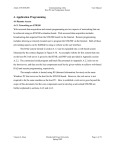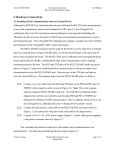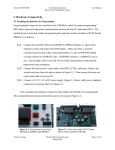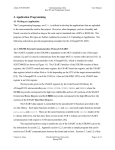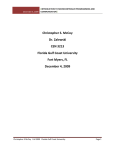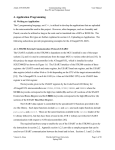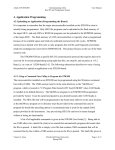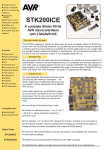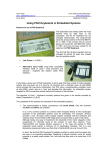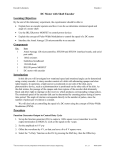Download Section 4.3 - Florida Gulf Coast University
Transcript
Atmel AVR STK500 Communicating with a Host PC and Temperature Sensor User Manual 4. Application Programming 4.3 Executing an Application The installed application will begin executing right after it is loaded into the target MCU of the STK500, right after the board is powered on, or right after the RESET button is pushed. The most important operations performed by an AVR application are typically written within an infinite loop nested in its main function, which is the case for both sample projects provided in Appendix section A.2. Therefore, these operations should run continuously while the board is powered on. It is imperative to remember that the functionality of the board with respect to its application software is dependent on the hardware setup (e.g. if PORTA is programmed to control the switches, then a 10-wire cable must properly connect the PORTA header to the SWITCHES header). Appendix section A.3, Troubleshooting, addresses how to resolve some of the common issues encountered that would cause the board to not respond as desired with respect to the installed application. The following set of instructions provides how to check whether the sample programs in Appendix sections A.2.1 and A.2.2.1 are running properly on the STK500 PCB. 4.3.1 Open the HyperTerminal program by going to “Start”, “All Programs”, “Accessories”, “Communications”, and selecting “HyperTerminal” as seen in Figure 4.28. If this is the first time HyperTerminal is used, enter an area code and follow the on-screen instructions given by the HyperTerminal program. Click “OK” to proceed. Vincent A. Rosa Florida Gulf Coast University Spring 2009 Page 1 of 6 Atmel AVR STK500 Communicating with a Host PC and Temperature Sensor User Manual Figure 4.28 Screenshot of how to start a HyperTerminal session. 4.3.2 Type a Name for the HyperTerminal session, say “com3_STK500_DAQ”, and select an Icon within the “Connection Description” window as shown in Figure 4.29. Click “OK” to proceed. Vincent A. Rosa Florida Gulf Coast University Spring 2009 Page 2 of 6 Atmel AVR STK500 Communicating with a Host PC and Temperature Sensor User Manual Figure 4.29 Screenshot of the Connection Description window used by HyperTerminal to establish a new connection. 4.3.3 Choose the appropriate COM port to which the STK500 is connected. The example in Figure 4.30 shows COM3 is used, but this can be different on another computer. The Troubleshooting section in Appendix A.3 explains how to determine which port is being used by the STK500. Figure 4.30 Screenshot of the Connect To window that HyperTerminal uses to establish at which COM port to receive or send data. 4.3.4 Select the appropriate COM properties to match the requirements given by the program uploaded to the target MCU (the ATmega8515L in this case). These settings Vincent A. Rosa Florida Gulf Coast University Spring 2009 Page 3 of 6 Atmel AVR STK500 Communicating with a Host PC and Temperature Sensor User Manual should match those given by Figure 4.31 for this example. Click “OK” to proceed. If an error occurs at this point, refer to Troubleshooting section A.3 of the appendix. Figure 4.31 Screenshot of the COM port settings window used by HyperTerminal to establish how to receive or send data via serial using the RS-232 protocol. 4.3.5 Push the RESET button on the STK500 board shown in Figure 4.32 to restart the program installed in the flash memory of the ATmega8515L. Now push one of the push-button switches. The results from these actions should yield a HyperTerminal window that looks like the one in Figure 4.33. If the results are not correct or seem to be garbled, refer to Troubleshooting section A.3 of the appendix; the firmware might need to be updated [16]. Vincent A. Rosa Florida Gulf Coast University Spring 2009 Page 4 of 6 Atmel AVR STK500 Communicating with a Host PC and Temperature Sensor User Manual Figure 4.32 Picture emphasizing the RESET button on the STK500 evaluation board. Figure 4.33 From left to right: a screenshot of a HyperTerminal session with respect to the test application for USART communication; a screenshot of a HyperTerminal session with respect to the myTWI-to-STK500 DAQ application. 4.3.6 Click on the X in the top-right corner of the HyperTerminal window as shown in the Figure 4.33 screenshots to exit the HyperTerminal program. Two pop-up windows will follow: the first shown in Figure 4.34 confirms whether you want to exit HyperTerminal (click “Yes” to proceed with exiting), and the second shown in Figure 4.35 asks whether you want to save the current HyperTerminal session (click “Yes” to save the session and then exit or click “No” to just exit). Vincent A. Rosa Florida Gulf Coast University Spring 2009 Page 5 of 6 Atmel AVR STK500 Communicating with a Host PC and Temperature Sensor User Manual Figure 4.34 Screenshot of the HyperTerminal pop-up window that appears when an attempt has been made to exit a HyperTerminal session. Figure 4.35 Screenshot of the HyperTerminal pop-up window that appears when an exiting an unsaved HyperTerminal session. This concludes how to execute the test application for USART communication and the myTWI-to-STK500 DAQ application. Appendix section A.3, Troubleshooting, covers some of the common errors that arise while carrying out the instructions provided in this section. Try editing the code used in this section to have one push-button switch correspond to one LED (say SW3 with LED3) where the LED will turn on or off when this button is pushed. Then try adding some code that will send a message to the host via USART when a different button is pushed, say SW7. It is important to know that PA3 controls SW3 and that PA7 controls SW7 since PORTA is connected to the SWITCHES header. Similarly, PC3 controls LED3 since PORTC is connected to the LEDS header. Also note from the provided sample programs in Appendix section A.2 that a carriage return (“\r”) must be sent when starting a new line (“\n”) in HyperTerminal; otherwise, the data sent will be skewed. Vincent A. Rosa Florida Gulf Coast University Spring 2009 Page 6 of 6






